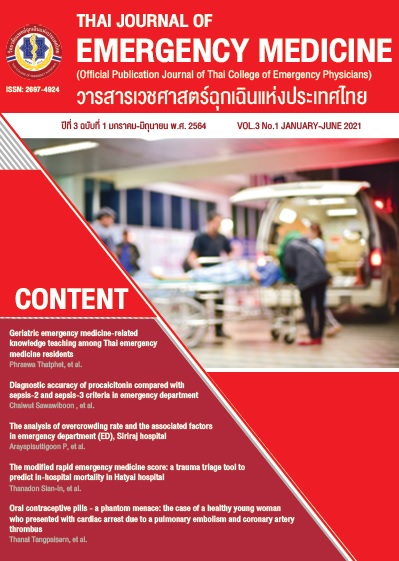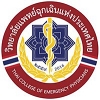Diagnostic accuracy of procalcitonin compared with sepsis-2 and sepsis-3 criteria in emergency department
Keywords:
SIRS, qSOFA, Procalcitonin, Organ dysfunction, Emergency DepartmentAbstract
Objective : As procalcitonin (PCT) level is significantly correlated with sequential organ failure assessment (SOFA) in ICU setting, we postulate that PCT could be substituted for SOFA in assessing sepsis in an emergency department (ED). Therefore, this study aims to compare the validity of PCT with Sepsis-2 and Sepsis-3 for diagnosing sepsis.
Methods : This prospective observational study was conducted in the ED, at one tertiary care hospital, Thailand from June 2017 to September 2017. Inclusion were consecutive adults, aged 18 years and older, with presumed infection admitted to the ED. Vital signs and the Glasgow Coma Scale (GCS) at nurse triage had been collected to access quick SOFA (qSOFA) and systemic inflammatory response syndrome (SIRS), including blood test for procalcitonin (PCT) level. Sepsis was diagnosed by positive hemoculture result or end-organ dysfunction. The diagnostic efficiency has been analyzed in the context of the area under the receiver operating characteristic (AUROC), sensitivity and specificity. The connection between serum PCT, qSOFA and SOFA was evaluated by the correlation test.
Results : We had 207 patients enrolled to the study, 49.8% were diagnosed with sepsis. The diagnostic value of PCT was as accurate as qSOFA. (AUROC 0.73 (0.66-0.80) vs. AUROC 0.71 (0.65-0.77), p 0.742). Compared to SIRS, the diagnostic accuracy was significantly higher for PCT (AUROC 0.58 (0.50-0.65) vs 0.73 (0.66-0.80), p 0.001). There was a statistical correlation between SOFA and procalcitonin, on the contraly, no correlation was found between qSOFA and procalcitonin.
Conclusions : Diagnostic efficacy of serum PCT was equivalent to qSOFA, but there was no correlation between qSOFA and PCT, consequently serum PCT played a limitation role in an ED.
References
Engel C, Brunkhorst FM, Bone HG, Brunkhorst R, Gerlach H, Grond S, et al. Epidemiology of sepsis in Germany: results from a national prospective multicenter study. Intensive Care Med. 2007;33(4):606-18.
Angus DC, Linde-Zwirble WT, Lidicker J, Clermont G, Carcillo J, Pinsky MR. Epidemiology of severe sepsis in the United States: analysis of incidence, outcome, and associated costs of care. Crit Care Med. 2001;29(7):1303-10.
Lever A, Mackenzie I. Sepsis: definition, epidemiology, and diagnosis. BMJ (Clinical research ed). 2007;335(7625):879-83.
Carlet J. Rapid diagnostic methods in the detection of sepsis. Infect Dis Clin North Am. 1999;13(2):483-94, xi.
Dellinger RP, Levy MM, Rhodes A, Annane D, Gerlach H, Opal SM, et al. Surviving sepsis campaign: international guidelines for management of severe sepsis and septic shock:2012. Crit Care Med. 2013;41(2):580-637.
Levy MM, Fink MP, Marshall JC, Abraham E, Angus D, Cook D, et al. 2001 SCCM/ESICM/ACCP/ATS/SIS International Sepsis Definitions Conference. Crit Care Med 2003;31(4):1250-6.
Vincent JL, Opal SM, Marshall JC, Tracey KJ. Sepsis definitions: time for change. Lancet(London, England). 2013;381(9868):774-5.
Sawawiboon C. Pitfalls in the management of sepsis in Thailand. J Med Asso Thai 2014;97 Suppl 1:S137-41.
Singer M, Deutschman CS, Seymour CW, Shankar-Hari M, Annane D, Bauer M, et al.The Third International Consensus Definitions for Sepsis and Septic Shock (Sepsis-3). JAMA. 2016;315(8):801-10.
Simpson SQ. New Sepsis Criteria: A Change We Should Not Make. Chest. 2016;149(5):1117-8.
Cortes-Puch I, Hartog CS. Opening the Debate on the New Sepsis Definition Change Is Not Necessarily Progress: Revision of the Sepsis Definition Should Be Based on New Scientific Insights. Am J Res Crit Care Med. 2016;194(1):16-8.
Patidar KR, Shaw J, Acharya C, Thacker LR, White MB, Ganapathy D, et al. No Association Between Quick Sequential Organ Failure Assessment and Outcomes of Patients With Cirrhosis and Infections. Clinical gastroenterology and hepatology : the official clinical practice journal of the Am Gastro Asso. 2017;15(11):1803-4.
Faix JD. Biomarkers of sepsis. Critical reviews in clinical laboratory sciences. 2013;50(1):23-36.
Schuetz P, Albrich W, Mueller B. Procalcitonin for diagnosis of infection and guide to antibiotic decisions: past, present and future. BMC medicine. 2011;9:107.
Sudhir U, Venkatachalaiah RK, Kumar TA, Rao MY, Kempegowda P. Significance of serum procalcitonin in sepsis. Indian J Crit Care Med. 2011;15(1):1-5.
Harbarth S, Holeckova K, Froidevaux C, Pittet D, Ricou B, Grau GE, et al. Diagnostic value of procalcitonin, interleukin-6, and interleukin-8 in critically ill patients admitted with suspected sepsis. Am J Res Crit Care Med. 2001;164(3):396-402.
Brunkhorst FM, Wegscheider K, Forycki ZF, Brunkhorst R. Procalcitonin for early diagnosis and differentiation of SIRS, sepsis, severe sepsis, and septic shock. Intensive Care Med. 2000;26 Suppl 2:S148-52.
Annam V, Maleedhu P, Bhaskar MV, Venugopal L. Evaluation of Serum Procalcitonin Levels and Sequential Organ Failure Assessment Score in Assessing the Severity and Outcome of Sepsis. Hematology. 2016;67(141):100.
Park HK, Kim WY, Kim MC, Jung W, Ko BS. Quick sequential organ failure assessment compared to systemic inflammatory response syndrome for predicting sepsis in emergency department. J Crit Care. 2017;42:12-7.
Ho KM, Lan NS. Combining quick Sequential Organ Failure Assessment with plasma lactate concentration is comparable to standard Sequential Organ Failure Assessment score in predicting mortality of patients with and without suspected infection. J Crit Care. 2017;38:1-5.

Downloads
Published
How to Cite
License
บทความที่ได้รับตีพิมพ์ในวารสารเวชศาสตร์ฉุกเฉินแห่งประเทศไทย ถือเป็นเป็นลิขสิทธิ์ของ วิทยาลัยแพทย์เวชศาสตร์ฉุกเฉินแห่งประเทศไทย
กรณีที่บทความได้รับการตีพิมพ์ในวารสารเวชศาสตร์ฉุกเฉินแห่งประเทศไทยแล้ว จะตีพิมพ์ในรูปแบบอิเล็กทรอนิกส์ ไม่มีสำเนาการพิมพ์ภายหลังหนังสือเผยแพร่เรียบร้อยแล้ว ผู้นิพนธ์ไม่สามารถนำบทความดังกล่าวไปนำเสนอหรือตีพิมพ์ในรูปแบบใดๆ ที่อื่นได้ หากมิได้รับคำอนุญาตจากวารสารเวชศาสตร์ฉุกเฉินแห่งประเทศไทย



